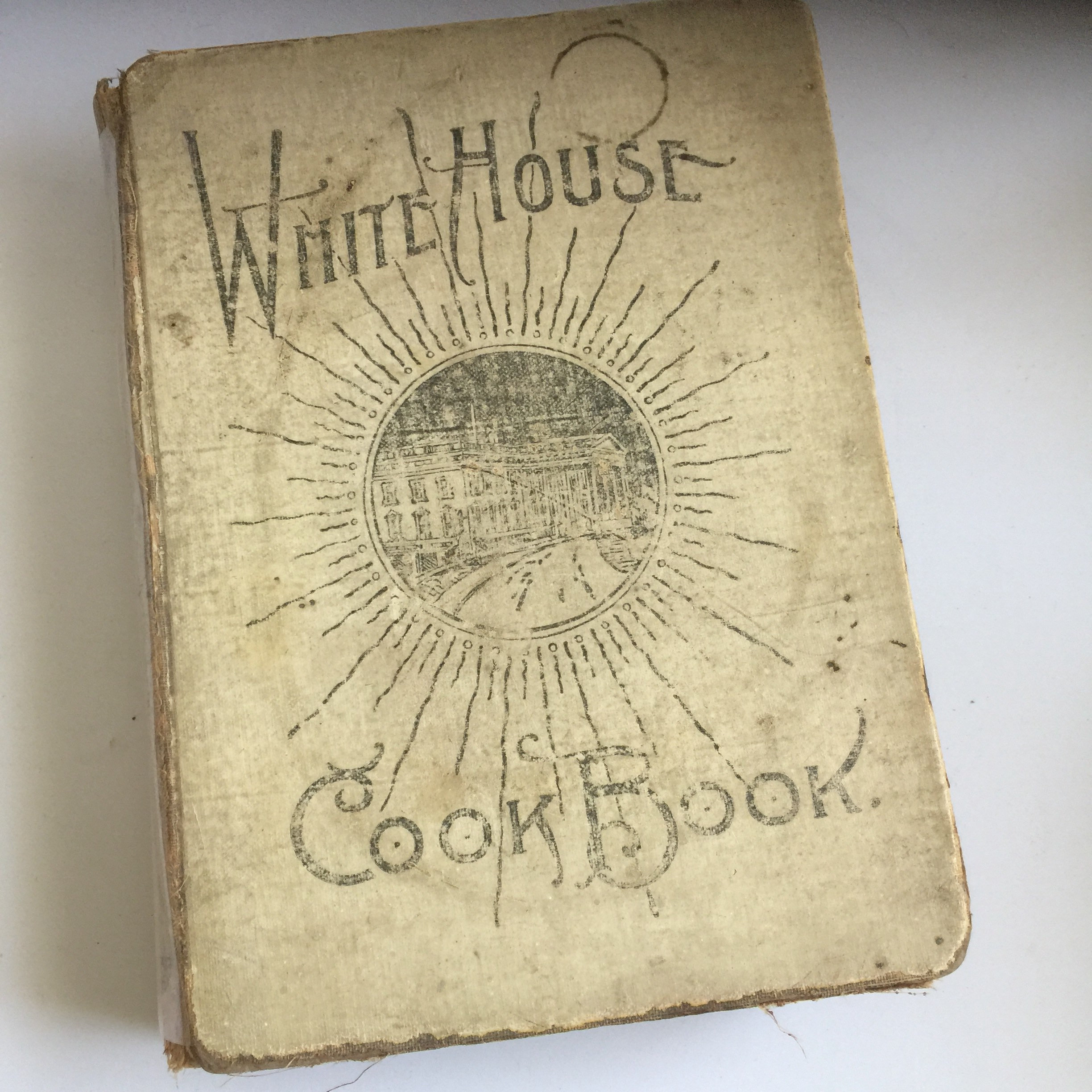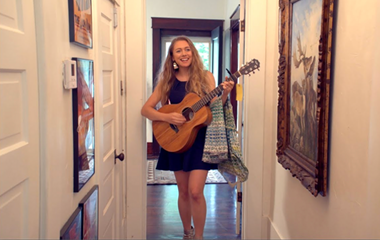Cookbooks provide a unique peek inside kitchens of the past. Kitchens and cooking have always been a central part of life and culture, so the historical information that can be gleaned from cookbooks is insightful and invaluable. Beyond that, they tend to be incredibly stimulating from a graphic design perspective.

Jennifer Krausnick of Vintage Cookbook Maven discovered vintage cookbooks early, after finding a book from the 1870s at a garage sale when she was just 10 years old. “It had lots of traditional recipes, mostly British in origin,” Krausnick says. “I tried a few of the recipes, including one for molasses taffy. It came out kind of sticky, but it was so exotic to a kid! Sadly, that cookbook and I parted ways during one of my cross-country moves. I can’t remember the title, but I still have fond memories of its yellowed pages, old paper smell and all those traditional recipes.”

Rachelle Markley, owner of Crooked House Books & Paper in Portland, Oregon, has been in the bookselling industry for almost 17 years. “One of my specialties is books by, for and about women, which naturally included cookbooks,” she says. “From there it has really grown into an important specialty for me.”

Shawn Underwood became interested in vintage cookbooks after seeing such a plethora of them at estate sales. When she found that they were popular for his customers, she grew her collection and eventually opened her cookbook-specific Etsy shop, VintageCookbooks4U. “Reading vintage and antique cookbooks has been quite informative,” says Underwood. “I’m learning about long-ago used ingredients for recipes, some of which I don’t recognize at all. I’m especially enjoying reading the notes written in the margins of the cookbooks finding old scraps of ancient recipes falling out of the cookbooks, or ‘notes to self’ from the cook.”
Vintage Cookbooks Through the Years
“Cookbooks have been around for centuries,” says Markley, “and they have evolved over time to reflect cultural and technological changes and trends.” As kitchens changed, so did cookbooks. With each fancy new kitchen addition—refrigerators, iceboxes, stoves, ovens—came new recipes and methods for cooking.

The First American Cookbook

Naturally, only British cookbooks were available when the colonies were initially settled. “However, by the late 1700s, Amelia Simmons published the first true American cookbook,” says Krausnick. American Cookery was first published in 1796. “It included recipes with American ingredients, such as pumpkin and corn, and was the first cookbook to suggest serving cranberries with turkey.”
Vintage Cookbooks of the 1800s
Around 1800, women started writing cookbooks with recipes and other tips for housekeeping. Fannie Farmer, a cooking school director, is often credited with being the first to implement uniform measurements in recipes. Farmer self-published The Boston Cooking School Cook Book in 1896.

Rae Manchester, owner of the Etsy shop Rare Books, has several cookbooks from the mid-1800s. “They are very different from modern cookbooks,” she says. “They deal mostly with dressing game, and mainly discuss technique instead of actual ingredients and measurements.”

One very popular vintage cookbook is the 1887 original edition of The White House Cookbook. Not to be confused with a few editions which have come out since then, the original book was written by Hugo Ziermann, who was then steward of the White House and catered to the First Family. It includes recipes, menus and housekeeping techniques of the era – all of which were quite different from today.

Vintage Cookbooks of the Early 1900s

In the early 1900s, cookbooks changed with the invention and availability of new kitchen technology. “With the arrival of the electric stove and temperature control, cooks were eager to share recipes,” says Manchester. “With refrigerators and freezers available around 1915, food was able to be stored. Prior to this period, people would actually eat rancid food.”

Vintage Cookbooks from the 1920s
The evolution of artwork seen in cookbooks provides an accurate record of the changing values of American society. “In the 1920s and earlier, food was simpler and eaters were more restrained,” says Krausnick. “Color lithography was used to produce delicate, dainty food images.”

For Markley, late Victorian and very early twentieth century cookbooks are the most interesting because they provide insight into an otherwise mysterious era of life. “The foods people ate then were so very different from today,” she says. “Most cookbooks were written with the assumption that the reader already knew how to cook, and instructions were sparse and basic.”

Cooking in Wartimes: 1920-1940
“Cookbooks from between the wars, from the 1920s to the 1940s, reflect a wide variety of cultural changes: modern conveniences and electricity were starting to come into use, women’s roles were starting to change a little bit as home economics took hold as a vocation, and society was changing economically with wartime frugalities and The Great Depression,” says Markley.

Krausnick specializes in softcover advertising cookbooks and has a particular affinity for those published during The Great Depression in the 1930s. “In the 1930s and early 40s, as regional produce became more widely distributed, images of fruits and vegetables became bold and splashy, accented with some great Art Deco design elements,” she says. “The bright, cheery images probably helped take people’s minds off the poor economic conditions, a trend echoed in the colorful kitchen wares of the Depression era.”

In the same way Homer Laughlin sought to improve attitudes with his colorful, cheerful Fiestaware during this era, the cookbooks did the same. “Many of the advertising cookbooks incorporate lithographs and illustrations with bright colors and handsome Art Deco fonts,” says Krausnick. “It was an attempt at cheerfulness during a very dismal time.”
World War II Cookbooks: 1940s
Part of what makes vintage and antique cookbooks especially interesting is the graphic design element. While these days, one might not look in a catalog for examples of fine art, that wasn’t the case in the 1900s. “Some well-known artists and illustrators got their start in food advertising art. Kewpies creator and Ladies’ Home Journal illustrator Rose O’Neill illustrated early advertising cookbooks for Jell-o, as did painter Maxfield Parish. There are some stunning examples of early graphic art in those pages.” For example, Ernest Hamlin Baker’s art can be found on the cover of an ice cream recipe booklet before his work was featured on a number of Fortune and Time magazine covers through the 1950s.

The graphic trends continued as America entered World War II. “The war brought in lots of patriotic images and themes emphasizing economy with rations and good nutrition in support of the war efforts,” says Krausnick. By 1942, there was a significant shortage of butter and other fats, which led to some very interesting substitutions and creativity on the part of cooks.

Post-War Prosperity Cookbooks

By the later 1940s and 50s, there were more cartoonish images of hungry husbands, happy housewives and apple-cheeked children, reflecting the more prosperous times.
Advertising in Vintage Cookbooks

While the 1930s are her favorite era, Krausnick has a collection of titles spanning the 1900s. Since her focus is advertising and appliance cookbooks, most of the authors are food companies or women who worked in a home economist role at those companies. “A lot of manufacturers produced recipe booklets for their companies or popular brands such as Pet Milk, Sealtest, Rawleigh’s, Crisco, Pillsbury, Betty Crocker, Presto and General Electric,” she says.

By creating unique recipes to highlight their food products, advertisers had an incredible impact on how Americans ate throughout the 1900s. “Ever wonder who thought of putting potato chips in sandwiches or crushing them to coat foods for frying?” asks Krausnick. “Or why so many people used to butter the bread before making a sandwich? Or how Green Bean Casserole, made with Campbell’s Cream of Mushroom Soup and Durkee Fried Onions, was born? It was the advertisers, of course.”

Cookbooks were even created with a central food product theme, like the 1939 Fritos cookbook “that calls for corn chips in everything from oysters to bread pudding,” says Krausnick. “Advertising cookbooks are an ode to food processing and commercialization, but the recipes themselves can be a bit hit or miss!”

Valuable Vintage Cookbooks
“Truly antiquarian cookbooks, from the 18th through mid-19th centuries, are the really valuable ones,” says Markley. “They are generally very scarce, and because they were heavily used, many did not survive. I am always excited to find any cookery book or ephemera from before 1870 or so.”
Underwood was in for a surprise when she bought a vintage book about soda fountains for $1. “I picked it up because I worked in my grandpa’s soda fountain in his drugstore as a little girl and I thought it would be fun to look at,” she says. The 1893 Macmahon Recipe Book Soda Dispenser Guide Chicago contained formulas for manufacturing carbonated water, syrups and other drinks. Written by Albert C. MacMahon of Chicago, Illinois, and published in 1893 by Goodall & Loveless of Chicago, the book includes recipes, instructions and old advertisements. Underwood ended up selling the book for $150.

One of the most valuable books in Markley’s current collection is an 1835 American Frugal Housewife by Lydia Child, which is listed for $175. “It is interesting because it is a very early example of the idea of economical cookery, and was written to housewives without servants,” says Markley. Another highly valuable vintage cookbook that Markley has sold is Cooking and Castle-Building by Emma P. Ewing published in 1883. “This was interesting because it was a cookbook written as a novel about writing a cookbook – very unusual!”


Cocktail books can also be a highly valuable category of vintage cookbook. “Early cocktail recipe books are also very collectible,” says Markley. “A while back I sold a copy of The Flowing Bowl: When and What to Drink, by Charles Webster, published in 1892, This is a very scarce and very early cocktail recipe book. The author invented a tremendous number of drinks, and the book has so much information about wine, beer and spirits.”


“Usually scarcity will make an antique book valuable, a first edition or a signed copy will also increase the value,” says Manchester. “Many of the great chefs wrote the classic cookbooks, including Julia Child, Jacques Pepin, Irma S. Rombauer and Prosper Montagne.”
A Note on Cookbook Condition: Unique to Vintage Books
“By their very nature, cookbooks get used and handled a lot,” says Krausnick. “So many don’t survive the years.”

The rarity of older cookbooks also means that collectors are a little less worried about condition than the average book collector. “Unlike most antique or vintage books which most buyers like to be in good condition, cookbooks do not need to be in pristine condition in order to sell,” says Underwood. “Honestly I’ve never had a buyer complain about a cookbook with ripped pages, taped spines or food spills, lots of food spills. Cookbooks have more character when they are well loved and you can feel you are delving into the previous owners past.”
Where to Find Vintage Cookbooks

Vintage cookbooks can be found in the most unlikely of places. “I find old cookbooks everywhere,” says Manchester. “I have found them in warehouses and in the middle of the desert.”
Of course, they can also be found in the most obvious places: at thrift shops, estate sales and yard sales. “I look for box lots at auction and occasionally find interesting titles at a garage sale, thrift store or antique shop,” says Krausnick.
For regular collectors, networking can also be valuable. “Most of them come to me,” says Markley. “People know I sell old cookbooks so I get phone calls. I do make house calls to look at books. I also look for them everywhere I go, bookstores, thrift stores and sometimes I buy them online.”
Each of the sources featured in this story sell vintage cookbooks on Etsy:
And of course, it’s always worth checking the EstateSales.org online auctions!


